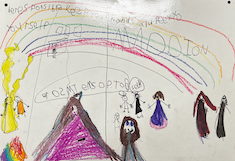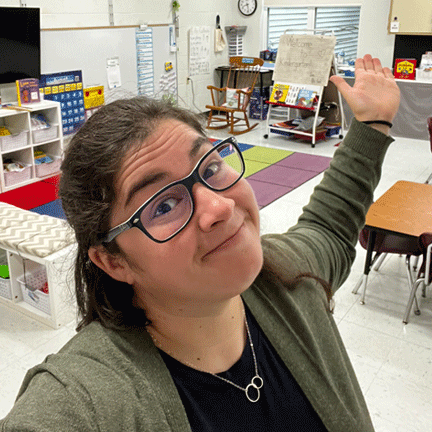“It was a hard recess,” the recess duty teacher said to me.
Although it wasn’t what I wanted to hear, it also wasn’t a surprise. There is a point in every school year when a class becomes comfortable with one another. They begin playing too rough and aren’t super kind to each other. They still need reminders to play appropriately.
I gathered the class in the meeting area and shared what I had been told. I asked them what they thought would help. I’ve often found that kids have some of the best ideas to help themselves behaviorally.
One child recommended they lose recess. Another suggested they not get to play on the field. And then one child said, “Wait, Mrs. Burk: Writing, writing will help!”
And then it started. I watched 18 kids go from solemn on the rug, feeling guilty for the choices they had made at recess, to empowered to make change.
The whispers turned into excited conversation…They started thinking and talking about the kinds of pictures and words that would be the most helpful to have on posters. Some kids went right over to the writing center but quickly came back to the rug and asked for “the big, thick paper.”
I sat in my rocking chair, kind of in awe. Little did these kids know, we were about to launch into our persuasive writing unit…the unit where we use writing to solve problems and change the world…and here they were, doing just that, completely of their own accord.
I chose to pivot in that moment and let them take this project on. I guided a little bit of brainstorming and encouraged children to think about words and pictures that would be helpful to the variety of ages in our preK-sixth-grade school…but then I just stepped back and watched.
The next 20 minutes likely appeared chaotic to anyone walking by our room…kids walking around, gathering materials, lying on the floor, some kids cutting paper, some kids taping papers together, markers strewn across tables, excited giggles and conversations, books open next to kids, kids sitting by the word wall as they wrote, kids sounding out words…and so much more.
Do you notice the common denominator in those things you would notice in the room? It’s the kids…The kids are doing it all. At first glance, perhaps some people may think the kids are not “in control” or “following directions,” when in reality, they are the direction. You see, despite the fact that they are five- and six-year-olds, they have the ability to problem solve and think in complex ways, often beyond the adults’ imagination. I have learned that it is critical to set up an environment that allows for this complex thinking and problem solving to occur freely.
Hadley and Isabelle asked for bigger paper. Connor and Hunter sat on the bench and talked about things they had seen happening at recess and how to fix it. Aviana grabbed an art caddy and got to work at the little white table. Violet and Olivia looked around, unsure what was happening, but Hazel noticed and asked them if they wanted to work with her. I watched Isla and Maddison plan out their pictures while Brody started with his words. Liam looked over at Hunter’s poster and said, “Don’t forget the e at the end so it says safe and not saf!” Hunter quickly added the silent e.
Slowly but surely, posters and signs were created. Twenty minutes later we had to go to specials and my kindergartners were actually disappointed to go to gym. That was a first for me.
A critical next step was my facilitating the follow-through. It would have been easy for me to collect the posters, put the room back together, and have the next thing ready when the kids came back from gym. Perhaps it would have been logical, even, to move on to the next “standard” or “lesson” and let these posters collect dust in a pile for a few weeks. I did have to rally what was left of my “nearing the end of the school day” energy to make a plan to allow for the kids to revise and finish their posters, get them to the laminator, and then bravely hang them on the playground for the rest of the school to see.
In the following days, we made those revisions, got those posters to the laminator, and came up with a plan to get them to hang on the playground fence. As soon as the rain broke one Friday afternoon, we marched ourselves outside and the kids chose where their posters made the most sense to hang. I helped with the logistics of the rings to hang them and took pictures of their proud smiles…and just looked across the playground at the incredible learners I had the honor to work with.
 I was so thankful I had pivoted that day after a tough recess. I was so thankful to have listened to the teacher voice in my head that encouraged me to follow the kids’ lead. Many times in this process I watched kids use writing with an intentional purpose. Beyond the practical skills of the writing process, they also practiced making decisions, collaborating, taking risks, and putting their work in public for others to experience it. This experience mattered, and by allowing it to happen, the kids knew they mattered too.
I was so thankful I had pivoted that day after a tough recess. I was so thankful to have listened to the teacher voice in my head that encouraged me to follow the kids’ lead. Many times in this process I watched kids use writing with an intentional purpose. Beyond the practical skills of the writing process, they also practiced making decisions, collaborating, taking risks, and putting their work in public for others to experience it. This experience mattered, and by allowing it to happen, the kids knew they mattered too.





